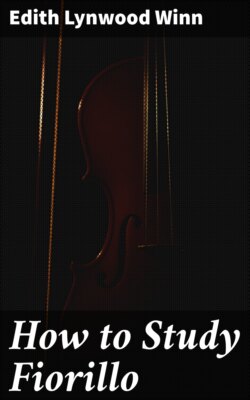Читать книгу How to Study Fiorillo - Edith Lynwood Winn - Страница 4
На сайте Литреса книга снята с продажи.
No. 1.
ОглавлениеTable of Contents
Many teachers of note cling to old traditions. The earliest extant editions of Fiorillo, by Ferdinand David and others, have no expression marks for the Largo of the first étude. This was originally played forte, counting four very slowly. The tone should be full and even, there being absolutely no variation. This is excellent practice for those who are inclined to play with a weak tone near the point of the bow. A broad stroke requires a fine arm and excellent bow control. The elbow joint should be very well relaxed. Such passages as occur in the fourth, fifth, and sixth measures should be played with some tone-color and taste, the eighth note being cut in anticipation of the rest.
[Listen]
To cultivate a broad, free bowing and a full tone, one should practice the martelé at the point of the bow, where attacks are likely to be weak. Also the frequent practice of the second Kreutzer étude with four notes slurred is excellent, the bowing being at the point, middle, and heel. Then there are staccato scales, which aid the student in securing a fine tone and freedom of style in the upper half of the bow: 1. One down-stroke and six notes staccato on the up-stroke; 2. Two down, at point, and two up staccato; 3. The same exercise, using triplets. Begin with the “G” scale in three octaves. The next thing to govern is the broad continuous tone. This can only be done by long and arduous practice of slow scales. A Berlin teacher plays one note for two minutes with no variation in force or intensity.
THE ALLEGRO.
The Hermann edition requires that this part of the first étude be played staccato. It is impossible to keep this up during the whole exercise. The original intention of Fiorillo was that it be played legato, with a broad, free stroke. The triplets are played in the same manner in the upper third, or toward the middle of the bow. The sixteenth notes must fall with evenness at the middle of the bow. This is an exceedingly fine study for securing a flexible wrist, and should be practiced very carefully.
[Listen]
At the Hochschule, in Berlin, few of the teachers stress Fiorillo, preferring the Kreutzer Études, followed by the Rode Caprices. Fiorillo has much to offer that Kreutzer[1] does not stress at all; therefore the études are very valuable.
